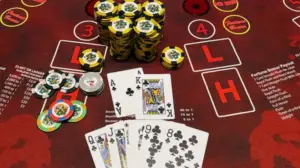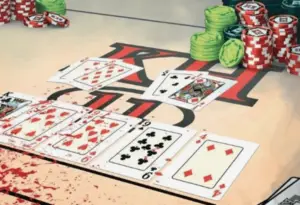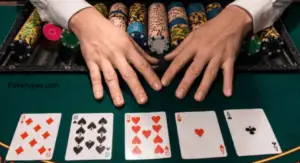Stud poker is a classic variant of poker characterized by face-up and face-down cards dealt in multiple betting rounds.
This non-positional game, where the first bettor can change each round, offers a thrilling test of skill and memory.
Originating during the American Civil War, stud poker quickly gained popularity among soldiers and later spread across the United States.
While Texas Hold’em dominates today’s poker scene, accounting for over 70% of all poker games played globally, stud variants like Seven-Card Stud still maintain a loyal following, particularly among seasoned players.
In fact, before the poker boom of the 2000s, Seven-Card Stud was the most widely played variant in American casinos.
Despite its decline in popularity, stud poker continues to challenge players with its unique gameplay, making it a favorite among those seeking a true test of poker prowess.
Types of Stud Poker
Based on the search results, here are the main types of Stud Poker and their key characteristics:
Five-Card Stud
Five-Card Stud is one of the oldest poker variants, originating during the American Civil War. Key features include:
Players receive 5 cards total: 1 face-down and 4 face-up
Four betting rounds
First bettor is the player with the highest-ranking visible cards
Simple gameplay, but mistakes can be costly due to limited betting options
Less popular now compared to its heyday in the 1920s-30s
Seven-Card Stud
Seven-Card Stud was the most popular poker variant before Texas Hold’em’s rise. Its main aspects are:
Players receive 7 cards: 2 face-down and 5 face-up
Five betting rounds
Players make their best 5-card hand from their 7 cards
More complex strategy due to more visible cards
Often played as high-low split
Remains popular in home games, poker clubs, and tournaments
Caribbean Stud Poker
Caribbean Stud Poker is a casino game variant of stud poker. Its distinguishing features are:
Played against the dealer, not other players
Players and dealers each receive 5 cards
One of the dealer’s cards is exposed
Players decide to bet or fold after seeing their hand
Dealer must have at least Ace-King high to qualify
Payouts based on hand strength against a pay table
These stud poker variants offer different levels of complexity and strategic depth, catering to various player preferences and skill levels.
Rules and Gameplay
General Rules:
Stud poker is played with a mix of face-up and face-down cards dealt in multiple betting rounds.
It’s typically a non-positional game, meaning the first bettor can change each round.
The most common variants are Seven-Card Stud and Five-Card Stud.
Betting Rounds and Structure:
Stud poker usually has a limited betting structure with fixed bet increments. In Seven-Card Stud:
There are five betting rounds: third street, fourth street, fifth street, sixth street, and seventh street (river).
Players start with an ante before cards are dealt.
On Third Street, the player with the lowest face-up card makes a forced bet (bring-in).
Betting limits typically double from the fifth street onwards.
In Five-Card Stud:
There are four betting rounds.
The first bettor is the player with the highest-ranking visible cards.
Hand Rankings: Stud poker uses standard poker hand rankings:
- Royal Flush
- Straight Flush
- Four of a Kind
- Full House
- Flush
- Straight
- Three-of-a-Kind
- Two Pair
- One Pair
- High Card
In case of ties, the highest card or kicker determines the winner. Some variants like Razz use low-hand rankings instead.
These rules provide a foundation for understanding stud poker gameplay, though specific rules may vary slightly between different variants and house rules.
Seven-Card Stud
Seven-Card Stud is a classic poker variant where players are dealt seven cards throughout the hand, with the goal of making the best five-card poker hand.
The game begins with each player receiving two face-down cards (hole cards) and one face-up card (door card).
The player with the lowest-ranking door card starts the action with a forced bet called the bring-in.
Betting then proceeds clockwise, with players having the option to fold, call, or raise. After the initial betting round, players receive three more face-up cards (on fourth, fifth, and sixth streets) and one final face-down card (on seventh street), with betting rounds following each deal.
The betting structure typically doubles on Fifth Street, transitioning from small bets to big bets.
Strategy in Seven-Card Stud heavily relies on memory and observation, as players must track exposed cards to determine the likelihood of improving their hands or the strength of opponents’ holdings.
Strong starting hands include high pairs, three-of-a-kind, or hands with strong flush and straight potential.
Skilled players pay close attention to their opponents’ exposed cards, betting patterns, and potential hand strengths, adjusting their play accordingly.
Additionally, understanding pot odds and carefully selecting starting hands are crucial elements of a successful Seven-Card Stud strategy.
Five-Card Stud
Five-Card Stud is a classic poker variant where players are dealt five cards throughout the hand, aiming to make the best five-card poker hand.
The game begins with each player receiving one face-down card (hole card) and one face-up card (door card). The player with the lowest-ranking door card starts the action with a forced bet called the bring-in.
Betting then proceeds clockwise, with players having the option to fold, call, or raise. After the initial betting round, players receive three more face-up cards in subsequent streets, with betting rounds following each deal.
Unlike the Seven-Card Stud, which deals seven cards total (three down, four up), the Five-Card Stud only deals five cards (one down, four up), making it easier to read opponents’ hands but limiting hand possibilities.
The betting structure typically uses fixed limits, with bets doubling on the later streets.
The basic strategy in a Five-Card Stud involves carefully selecting starting hands, paying close attention to opponents’ exposed cards, and avoiding chasing draws.
Strong starting hands include high pairs or two high cards of the same suit. Players should be prepared to fold if their visible cards are clearly beaten by an opponent’s hand, as bluffing opportunities are limited due to the high proportion of exposed cards.
Caribbean Stud Poker
Caribbean Stud Poker is a popular casino variant of stud poker that pits players directly against the house rather than each other.
The game is played with a standard 52-card deck and follows a straightforward structure. Players begin by placing an ante bet, after which they and the dealer are each dealt five cards.
One of the dealer’s cards is exposed, giving players partial information to base their decisions on.
Players then choose to either fold, lose their ante, or raise by placing an additional bet equal to twice their ante. The dealer must qualify with at least Ace-King high for the hand to proceed.
If the dealer doesn’t qualify, players win even money on their ante, and their raised bets are returned.
If the dealer qualifies and the player’s hand beats the dealer’s, both the ante and raise are paid out according to a predetermined paytable, with higher payouts for stronger hands.
The house edge in Caribbean Stud Poker is typically around 5.22%, making it less favorable than some other casino games.
However, the potential for large payouts on premium hands, including a progressive jackpot in many casinos, continues to attract players.
Payouts can range from 1:1 for a pair or less up to 100:1 for a royal flush, with exact paytables varying by casino.
Stud Poker Strategy
Here are some key points about Stud Poker strategy:
Starting Hand Selection:
The best-starting hands are three-of-a-kind (rolled-up trips), with three aces being the absolute best.
High pairs in the hole (hidden) are very strong starting hands.
High pairs with one card showing, especially if it’s the highest card visible, are also strong.
Hands with strong flush and straight potential are reasonable starting hands.
Reading Opponents’ Hands:
Pay close attention to opponents’ visible cards and what possible hands they could make.
Be aware of what cards have been folded by other players.
Use betting patterns and player tendencies to narrow down likely holdings.
Importance of Memory:
Memory is considered one of the most crucial skills in Stud Poker, more so than in other poker variants.
Good players remember what cards their opponents were showing before folding.
This allows you to know what cards are still available to help your hand and which ones are gone.
Remembering folded cards helps calculate odds and make better decisions.
Other Key Strategy Points:
Be tight and aggressive in your play.
Understanding pot odds is vital for success.
Always be aware of what cards are showing on the table.
Avoid calling on the last betting round with hands that can’t beat what an opponent is showing.
The reduced “luck” factor in Stud compared to Hold’em means skill and memory are even more important.
Variations of Stud Poker
Stud poker offers several popular variations that add diversity to the game. High-Low Split, also known as Hi-Lo, is a variant where the pot is divided between the highest and lowest hands, with players aiming to “scoop” both halves.
In Seven-Card Stud Hi-Lo, players use their seven cards to make the best five-card high hand and the best five-card low hand, with an “eight or better” qualifier for the low.
Razz, or Seven-Card Stud Low, is a lowball variant where the goal is to make the lowest possible five-card hand.
In Razz, aces are always low, and straights and flushes don’t count against the hand, making A-2-3-4-5 the best possible hand.
Mississippi Stud is a casino table game variation that pits players against a paytable rather than the dealer.
Players receive two cards and can make up to three raises as community cards are revealed. Winning hands start at a pair of jacks or better, with a royal flush paying 500 to 1 on all bets.
These variations offer different strategic challenges and appeal to players seeking alternatives to traditional high-hand stud poker games.
Stud Poker in Tournaments and Cash Games
Stud poker strategies differ significantly between tournaments and cash games. In tournaments, players must adapt to increasing blinds and antes, necessitating a more aggressive approach, especially in the later stages.
Tournament players should loosen their starting hand requirements and be willing to make more aggressive moves to accumulate chips.
Stack sizes become crucial, with short-stacked players needing to take more risks. In cash games, players can afford to be more patient and selective with their starting hands, as the stakes remain constant.
Cash game players can focus on exploiting opponents’ tendencies over time and have the luxury of rebuying if they lose their stack.
The rake structure also differs, with tournaments typically having a one-time fee, while cash games take a percentage from each pot.
Online Stud Poker
Online stud poker has gained popularity on platforms like PokerStars, 888poker, and PartyPoker, offering players convenient access to various stud variants.
The main differences between online and live stud poker lie in the pace of play and player interactions.
Online games move significantly faster, with automated dealing and betting, allowing players to see more hands per hour.
While live games offer physical tells and social interaction, online play relies more on betting patterns and timing for player reads.
Online platforms also tend to have a wider range of stakes and game variations available, catering to players of all skill levels and preferences.
Additionally, online stud poker often features rakeback and promotions not typically found in live games.
Stud Poker vs. Other Poker Variants
| Feature | Stud Poker | Texas Hold’em | Draw Poker |
| Number of Cards Dealt | 5 (in Five-Card; 7 in Seven-Card) | 7 (2 hole cards + 5 community) | 5 (commonly in Five-Card Draw) |
| Visible Cards | Some cards are visible | 2 hole cards, 5 community cards visible | All cards hidden initially |
| Blinds vs. Antes | Antes are used | Blinds are used | Antes or blinds can be used |
| Starting Hand Strategy | Focus on visible cards and overall hand potential | Utilize community cards and betting patterns | Emphasizes bluffing and drawing |
| Community Cards | No community cards | 5 community cards | No community cards |
| Player to Bet First | Varies by hand | Player with the small blind bets first | Varies by hand |
| Card Exchange | No card exchange | No card exchange | Players can exchange cards |
| Betting Rounds | 4-5 (depending on variant) | 4 | 2 |
| Position Importance | Changes each round | Fixed throughout the hand | Fixed throughout the hand |
| Reading Opponents | Easier due to visible cards | Relies more on betting patterns | Relies heavily on betting patterns and tells |
| Popularity | Less popular than Hold’em | Most popular variant | Less popular than Hold’em |
| Skill Focus | Memory and observation | Probability and position | Bluffing and hand improvement |
Advanced Concepts
Advanced concepts in stud poker include mastering pot odds, bluffing techniques, and understanding position importance.
Pot odds in stud are calculated similarly to other poker variants but with more visible information from exposed cards. This allows for more accurate assessments of hand strength and drawing potential.
Bluffing in stud requires careful consideration of exposed cards and betting patterns, as observant opponents can more easily detect inconsistencies.
Position in stud is dynamic, changing with each betting round based on the highest showing hand.
While not as crucial as in hold’em, the position still influences betting decisions and the ability to control pot size.
Skilled players adapt their strategies based on their changing position throughout the hand, using it to gain information and apply pressure on opponents.
Conclusion
The future of stud poker remains uncertain but promising. While Texas Hold’em continues to dominate the poker landscape, there’s a growing interest in mixed games and classic variants like stud poker.
Online platforms are increasingly offering stud games, catering to players seeking diverse poker experiences.
For those looking to learn or improve their stud poker skills, several resources are available. Books like “Seven-Card Stud for Advanced Players” by David Sklansky and Mason Malmuth remain valuable.
Online training sites such as Run It Once and Upswing Poker offer stud poker courses. Additionally, forums like Two Plus Two provide discussions and strategy advice from experienced players.
As the poker community continues to evolve, stud poker may see a resurgence, especially among players seeking to diversify their skills and challenge themselves with different poker variants.























































